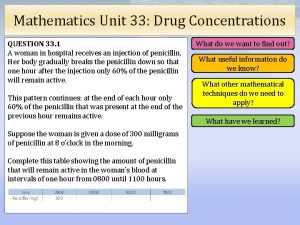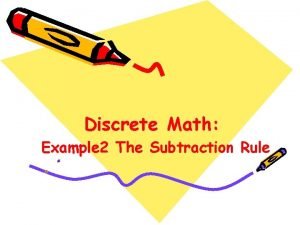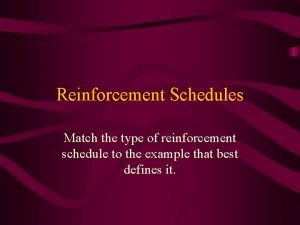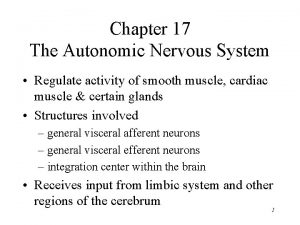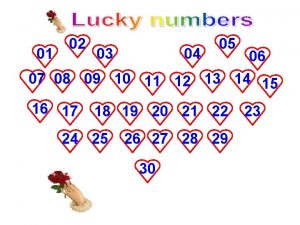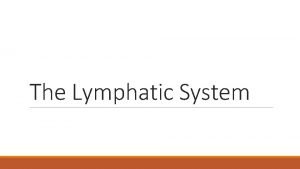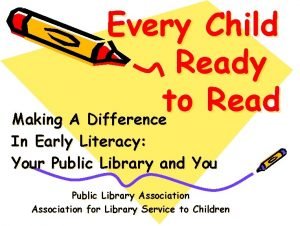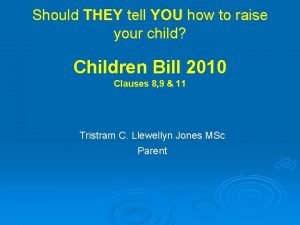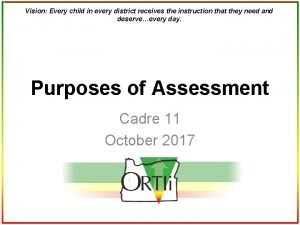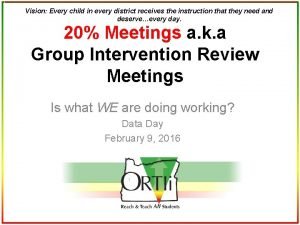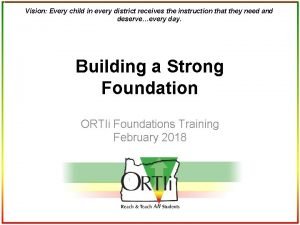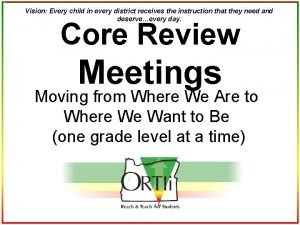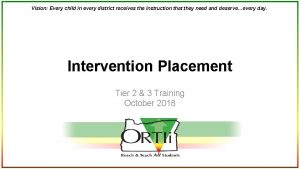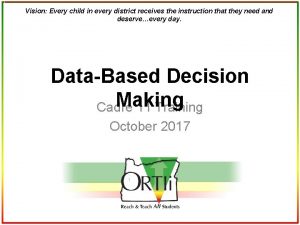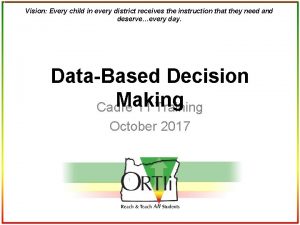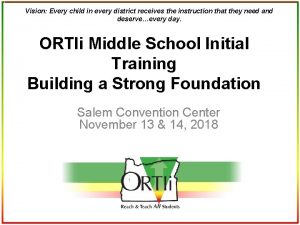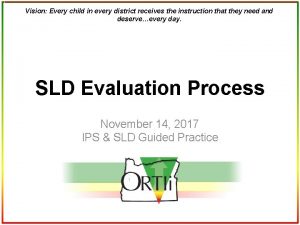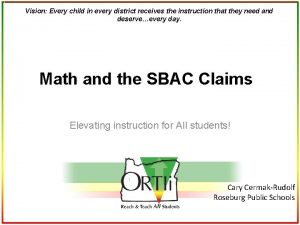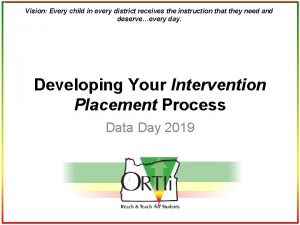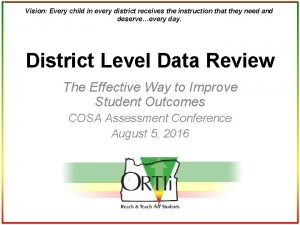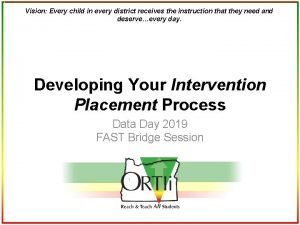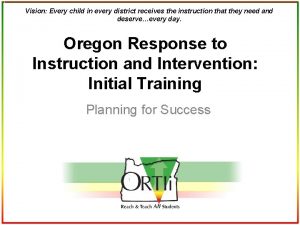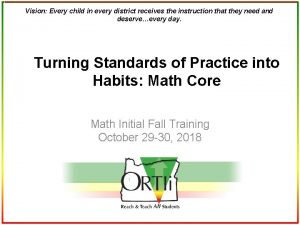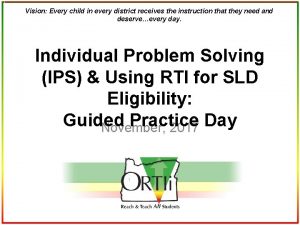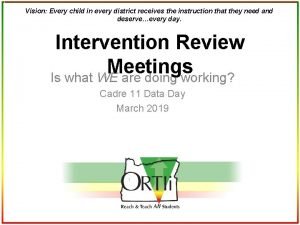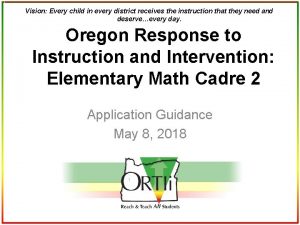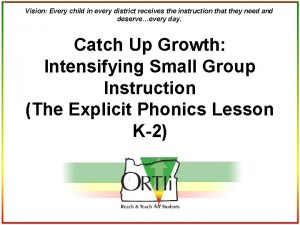Vision Every child in every district receives the


























- Slides: 26

Vision: Every child in every district receives the instruction that they need and deserve…every day. Middle School Intervention Placement

Talk Time • What is your current process for: – Determining WHO receives reading intervention? – Determining WHICH reading intervention they receive? • Using data/information from elementary interventions to help with placement?

RTI Essential Components Clear Vision of Learning for ALL SLD Decision Making Decision Rules Progress Monitoring Intervention BIT Meets Regularly Initial and Ongoing PD Placement Ongoing Coaching Interventions Intervention Review Universal Screening/EWSObserve & Principal Attends RTI Meetings Core Review Actionable Feedback Core/Coordinated Literacy Leadership Growth Mindset & High Expectations For ALL Students Teaming & DBDM Professional Learning Culture of Collaboration to Improve Outcomes

Installation Matrix

Matched to Student Need Focus AND Intensity (the right skills) (the right amount)

Four Steps to Implement RTI Correctly (Article by Vanderheyden et al. , 2016 in Edweek) • First, it is time for smarter screening • Second, the focus of effective RTI implementation must be core instruction • Third, schools need effective intervention systems that match student need • Fourth, intervention intensity is not the same as “longer and louder”

Four Steps to Implement RTI Correctly (Article by Vanderheyden et al. , 2016 in Edweek) “…intervening without consideration for what a student specifically needs is like choosing an antibiotic without identifying the bacteria causing an infection. ”

Intervention Placement Logistics: Decision Rules • How many/what percentage of your students can you serve in interventions? – What is your capacity? • Scheduling, Materials, Staffing

Intervention Placement Logistics: Decision Rules • How do you determine which intervention they receive? – Based on screening data – Validated by additional diagnostic data sources

+Intervention DIAGNOSTIC What help do they need? SCREENING Who needs more help? Core Curriculum/Coordinated Literacy

WHY is the student not on track? At Risk Student Attendance Behavior Are they able to WHAT behaviors are they referred attend? for? Are they absent WHERE do the full day or behaviors occur? partial day? Course Proficiency Which courses are they failing? Is it a can’t do or won’t do issue? What do we With WHOM do the know about their behavior occur? literacy skills?

Reading Skills Build on Each Other Reading Comprehension Oral Reading Fluency Phonics (Word Reading/Decoding) Phonemic Awareness Vocabulary Listening Comprehension Foundational Skills

Reading Activity • You will have 1 minute to read the passage on the next slide. • Do your best reading. After you have read it, you will be asked to answer some questions about what you read.

The Minnows built many cities, which were different from those of other accident situations in two ways. At the heart of each Minnow city stood a place rather than a teepee. Also, Minnow cities did not have walls around them. Instead, people deepened on the sea and navy for production. One of the largest cities covered about 28 acres, or 11. 2 hectares. About one fifth of the area was taken up by a five-story place that served as a governor building, teepee, factory, and warehouse. Its walls were built of stone and sun-dried brick farmed with wooden beams. The Minnows doctored the inside walls with brightly colored fritos, or water color paintings made on damp plaster. The place had bathrooms with bathtubs and flush toilets. It also had hot and cold running water and potable fireboxes to heat rooms.

Questions 1. Who built many cities? The Minoans 2. In what two ways were these cities different They had a palace instead of from others? a temple in the center and did not have walls around them 1. Upon what did people rely for protection The sea and the navy 2. What were the four functions of the palace? Government building, temple, factory, warehouse 5. What brightly colored things decorated the inside walls? Frescoes

The Minoans built many cities, which were different from those of other ancient civilizations in two ways. At the heart of each Minoan city stood a palace rather than a temple. Also, Minoan cities did not have walls around them. Instead, people depended on the sea and navy for protection. One of the largest cities covered about 28 acres, or 11. 2 hectares. About one fifth of the area was taken up by a five-story palace that served as a government building, temple, factory, and warehouse. Its walls were built of stone and sun-dried brick framed with wooden beams. The Minoans decorated the inside walls with brightly colored frescoes, or water color paintings made on damp plaster. The palace had bathrooms with bathtubs and flush toilets. It also had hot and cold running water and portable fireboxes to heat rooms.

Phonics and accuracy are important Words missed per page when accuracy is… The Secret Life of Bees 7 th Grade My Brother Sam is Dead 5 -6 th grade The Magic School Bus 2 nd – 3 rd grade 95% 98% 99% 18. 5 7. 4 3. 6 15 6 3 6 2. 4 1. 2 Richard Allington

Importance of Reading Fluency Assuming 300 words per page in a middle school text book, how long will it take a student to finish a 15 page (1 chapter) reading assignment (4500 Words)? 180 Minutes 135 120 60 90 45 15 30 45 60 120 90 60 30 0 1 2 3 # of Chapters 4 Gap 150 WPM

Reading Skills Build on Each Other Reading Comprehension Oral Reading Fluency Phonics (Word Reading/Decoding) Phonemic Awareness Vocabulary Listening Comprehension Foundational Skills

Reading Skills Build on Each Other #3 Reading Comprehension Foundational Skills #1 Phonics (Word Reading/Decoding) Vocabulary #2 Oral Reading Fluency

What assessments do you have to measure these skills? Student Skills Word Reading/ Decoding Skills Oral Reading Fluency Text Comprehensio n and Vocabulary Instructional Placement Core ELA +Comp/Vocab Core ELA +Fluency/Comp Core ELA +Decoding +Fluency/Comp

Available Middle School Assessments Oral Text Publisher Word Reading/ Decoding Skills Reading Fluency Comprehension and Vocabulary ORF Accuracy ORF Maze, Silent Reading DIBELS 8 th Edition ORF Accuracy, NWF, WRF ORF Maze Easy. CBM PRF Accuracy, WRF PRF MCRC Fastbridge CBMreading Accuracy CBMreading a. Reading, CBMcomp AIMSWEB ORF Accuracy ORF Reading Comprehension Acadience 7 -9 (formerly DIBELS CARI) Phonics SBAC, STAR, Screener, NWF = Other Nonsense Word Fluency, WRF = Word Reading Fluency, PRF = Passage Reading SRI Fluency, MCRC = Multiple. Phonics Inventory Choice Reading Comprehension

Including Elementary Data • Consider data from your elementary schools to help inform initial placement: – What interventions have they already received? – What elementary screening, progress monitoring & diagnostic data do they already have? • Phonics/Accuracy, Fluency, Comprehension – Students who have not met elementary benchmarks should continue to work on those skills until they do

Intervention Placement Protocol Skills Text Comprehensio n / Vocabulary Oral Reading Fluency Instruction/ Intervention Focus If Proficient Core ELA Assessment SBA C SRI If Not Proficient CARI ORF Passag e If NOT Accurate Phonics Word Reading / Decoding Screene r Programs Time/Grou Used p Size 45 minutes Nat Geo 30 students Progress Monitoring Core ELA If Accurate +Comp / Vocab AND Fluent Intervention Core ELA If Accurate +Fluency / Comp / but NOT Vocab Fluent Intervention Read 180 Third Quest +45 min 20 students Third Quest +45 min 12 students Corrective +45 min 10 Reading students +45 min RGR Core ELA +Word Reading / Phonics 8 students Boost/Blitz Phonics

Another Example: TTSD

Team Time • Develop your decision rules around how many students will receive interventions • Determine which assessments will be used to place students in interventions • Develop/refine your protocol for placing students in interventions using the examples as a guideline • Continue earlier conversations around interventions
 Every child every day
Every child every day Cs766
Cs766 Child vision foundation
Child vision foundation Left child right sibling tree
Left child right sibling tree A woman in hospital receives an injection of penicillin
A woman in hospital receives an injection of penicillin A computer company receives 350 applications
A computer company receives 350 applications A blueberry picker receives $1 after filling 3 pint boxes.
A blueberry picker receives $1 after filling 3 pint boxes. Tribeculated
Tribeculated A wise man receives correction
A wise man receives correction The left side of the heart receives blood from the
The left side of the heart receives blood from the Mark receives a score report detailing his performance
Mark receives a score report detailing his performance Who teases romeo about rosaline and his love-sickness
Who teases romeo about rosaline and his love-sickness Miss cuba receives an invitation
Miss cuba receives an invitation Which target organ receives dual innervation
Which target organ receives dual innervation Ms jones isn't as nice ms smith
Ms jones isn't as nice ms smith When earth receives energy from the sun, ____.
When earth receives energy from the sun, ____. Oblique pericardial sinus
Oblique pericardial sinus Popularly called lymph glands
Popularly called lymph glands Average weather conditions over time
Average weather conditions over time Short tube that receives purified lymph
Short tube that receives purified lymph Every child ready to read six skills
Every child ready to read six skills Every child a seed
Every child a seed Every mother loves her child tag question
Every mother loves her child tag question Why was every child matters scrapped
Why was every child matters scrapped Every child matters be healthy
Every child matters be healthy Every child matters honouring and remembering
Every child matters honouring and remembering Every child is gifted they just unwrap
Every child is gifted they just unwrap




